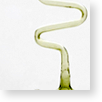
The greatest progress in modern chemistry was attained by perfecting instrumentation able to control fire, the chief element used by chemists to analyze substances. In the 18th century, the discovery that variations in temperature affect chemical reactions stimulated the systematic use of the thermometer and the pyrometer (for measuring the expansion of metals and the temperature of furnaces). Thanks to these instruments calorimetric standards were significantly raised, allowing the power of fire to be more efficiently controlled and measured.
Alcohol thermometer
Inv. 2040
M. Gallonde, Paris, late 18th cent.
Alembic dome
Inv. 3782
Maker unknown, 18th cent.
Alembic domes
Inv. 3779, 3780, 3781
Maker unknown, 18th cent.
Bottle with curved pouring pipe
Inv. 3786
Maker unknown, 18th cent.
Bottle with serpentine neck
Inv. 1941
Maker unknown, 18th cent.
Bottle with side spout
Inv. 1649
Maker unknown, 18th cent.
Chemical apparatus
Inv. 1714
Maker unknown, 18th cent.
Furnace
Inv. 3916
Maker unknown, second half 18th cent.
Long-necked matrass
Inv. 1920
Maker unknown, 18th cent.
Matrass
Inv. 1922
Maker unknown, 18th-19th cent.
Mercury thermometer
Inv. 2038
Felice Fontana [attr.], Italian, second half 18th cent.
Pyrometer or dilatometer
Inv. 573
Maker unknown, second half 18th cent.
Retort
Inv. 3915
Maker unknown, second half 18th cent.
Retort
Inv. 1756
Josiah Wedgwood, England, second half 18th cent.
Retort
Inv. 3787
Maker unknown, 18th cent.
Retort
Inv. 1755
Josiah Wedgwood, England, second half 18th cent.
Retort
Inv. 1754
Josiah Wedgwood, England, second half 18th cent.
Retorts
Inv. 1752, 1753
Josiah Wedgwood, second half 18th cent.
Tripod-mounted furnace
Inv. 3914
Maker unknown, second half 18th cent.
Tubes terminating in bubbles
Inv. 1938, 1940
Maker unknown, 18th cent.
Wedgwood pyrometer
Inv. 546
Josiah Wedgwood, England, late 18th cent.






























